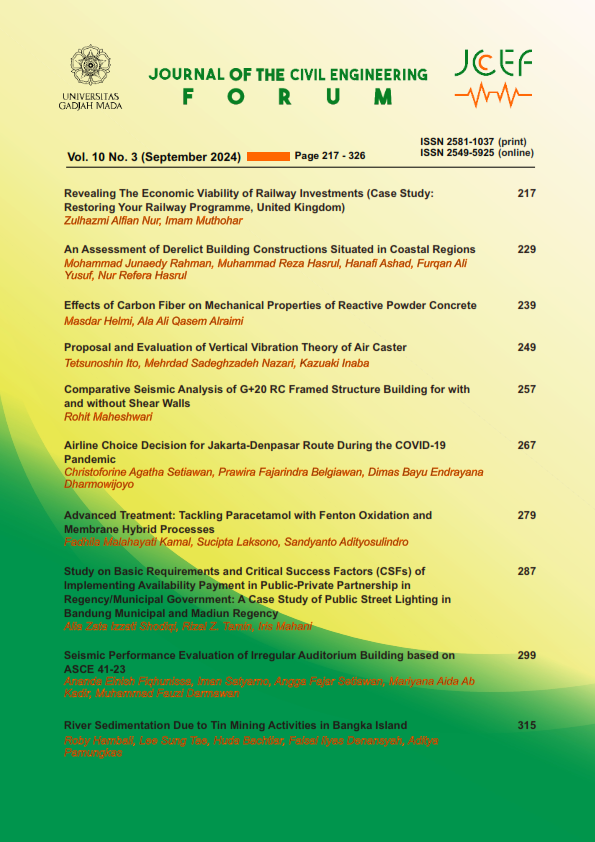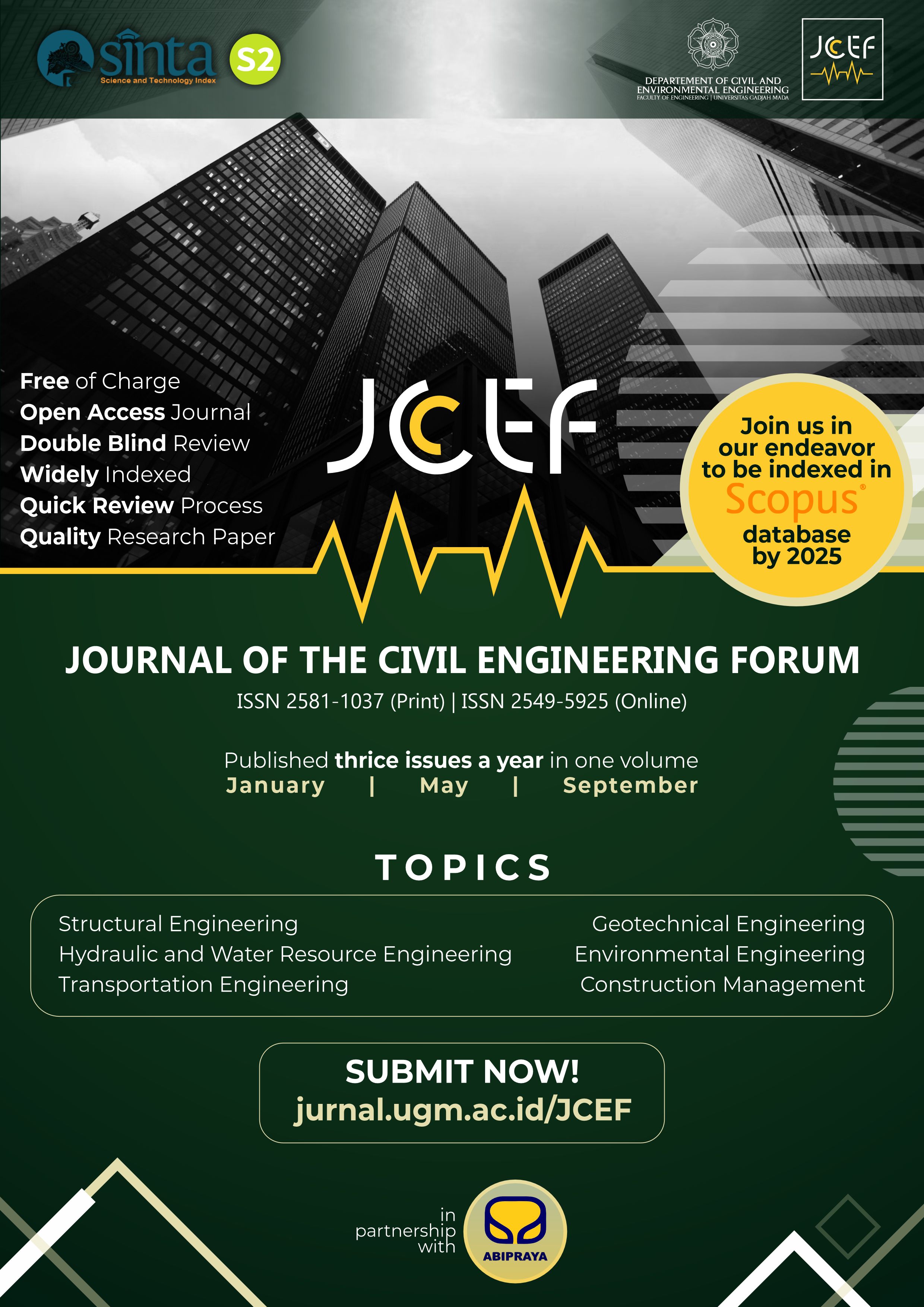Proposal and Evaluation of Vertical Vibration Theory of Air Caster
Abstract
Urbanization and human development have increased the exposure of seismic risk. Therefore, engineers need to develop new and more efficient technologies to protect people and objects from the disastrous consequences of earthquakes. Air casters have gained attention and have been utilized in the past decade as effective seismic vibration control devices. Although such active isolation systems perform well in mitigating horizontal input vibrations, they might cause excessive rocking motions, if not designed properly. This fact emphasizes the importance of exploring the vertical dynamic properties of air isolation systems. To gain such an understanding, this research examines and proposes a formula for the vertical stiffness and damping of air caster systems. Theoretical solutions to the vertical stiffness and damping of such systems have been explored. Computer simulations considering fluid-structure interaction have also been performed to understand the dynamic behavior of the supporting air layer. Results have been compared to validate the proposed dynamic quantities within the considered simulation range. It is also concluded that the instantaneous air layer thickness, representing the air chamber pressure, and the bearing inlet flow rate are the key factors in determining the dynamic properties of the air layer. It is concluded that to evaluate the performance of the air caster seismic isolation device and increase the probability that the qualified seismic isolation performance will be exhibited, it is necessary to investigate which parameters are greatly involved in the viscous damping coefficient and the spring constant of amass-spring-damper system equivalent to the air caster isolation system.
References
Adachi, T. and Takahara, K. (2022), ‘Development of a semi-active damper vibration control system with a simple structure on a fragile wooden house’, Transactions of the Society of Instrumentation and Control Engineering 58(11), 519–526. URL: https://doi.org/10.9746/sicetr.58.519
Aoki, Y., Hiramatsu, A., Wachi, T., Aoki, T., Kajiwara, K. and Tagawa, Y. (2015), ‘Development of active seismic base isolation system with mechanical controller’, Transactions of the JSME 81(823), 1–14. URL: https://doi.org/10.1299/transjsme.15-00230
AreGo Inc. (2024), ‘Air caster technology’. [Accessed 3 April 2024]. URL: https://www.aerogo.com/products/are-air-casters-right-for-you/
Asami, T. (1994), ‘Utilization of viscous damping’, Noise Control 18(3), 120–125.
Bird, J., Santer, M. and Morrison, J. (2018), ‘Experimental control of turbulent boundary layers with in plane travelling waves’, Flow, Turbulence and Combustion 100, 1015–1035. URL: https://doi.org/10.1007/s10494-018-9910-6
Fujita, S., Minagawa, K., Tanaka, G. and Shimosaka, H. (2011), ‘Intelligent seismic isolation system using air bearings and earthquake early warning’, Soil Dynamics and Earthquake Engineering 31, 223–230. URL: https://doi.org/10.1016/j.soildyn.2010.04.003
Furuya, O., Takito, K., Kurabayashi, H., Sampei, K. and Yamazaki, K. (2020), Study on multifunctional base isolation system using air-floating technique, in ‘ASME Pressure Vessels & Piping Conference’.
Ishiyama,Y.(1992), ‘Distribution of seismic layer shear forces and base-shear coefficients for various buildings’, The Architectural Institute of Japan’s Journal of Structural and Construction Engineering 439.
Ito, M., Sanbonsuga, R., Maeda, M. and Furuno, Y. (2013), Experimental study on seismic performance of reinforced shear walls added to src structures, in ‘Proceedings of the Annual Meeting of the Concrete Institute’, Vol. 35, pp. 379–384.
Kojima, T., Inaba, K. and Takada, Y. (2018), A study for theoretical modeling of cavitation inducement from the solid-fluid interface with fluid-structure interaction, in ‘ASME Pressure Vessels & Piping Conference’, Czech Republic.
Mitsuishi, A., Shimura, T. and Iwamoto, K. (2021), ‘Traveling wave control technique for drag reduction of wall turbulence’, The Japan Society of Fluid Mechanics, Nagare 40, 271–278. URL: https://doi.org/10.5351/nagare.40.271
Onoda Sngyo Inc. (2024), ‘Air caster technology’. [Accessed 20 April 2024]. URL: https://www.onoda-sg.co.jp/air/
Sadeghzadeh Nazari, M. and Ghafory Ashtiany, M. (2011), Influential parameters for the design of non structural components in multi-story buildings, in ‘3rd ECCOMAS Thematic Conference on Computational Methods in Structural Dynamics and Earthquake Engineering, COMPDYN’, Greece.
Sadeghzadeh Nazari, M., Numada, M. and Meguro, K. (2015), Introducing a new tuned mass damper system, in ‘7th International Conference of Seismology and Earthquake Engineering, SEE7’, Iran.
Sansei Air Danshin System Inc. (2024), ‘Air danshin system’. [Accessed 20 April 2024]. URL: https://airdanshin.co.jp/
SN-Engineering Inc. (2024), ‘Air caster technology’. [Accessed 20 April 2024]. URL: https://sne-inc.com/aircaster/
Suwada, H., Fukuyama, H., Mukai, T. and Nomura, S. (2005), Structural testing of high-performance earthquake-resistant elements that combine strength, rigidity, and toughness, in ‘Proceedings of the Annual Meeting of the Concrete Institute’, Vol. 27, pp. 1087–1092.
Xu, P., Inaba, K., Takeishi, H. and Kagawa, T. (2023), Feasibility and optimization of nozzle flapper system for position measurements of high-speed rotation spindle with aero static bearings, in ‘ASME Pressure Vessels & Piping Conference’, USA.
You, J. H. and Inaba, K. (2013), ‘Fluid–structure in teraction in water-filled thin pipes of anisotropic composite materials’, Fluids and Structures 36, 162–173. URL: https://doi.org/10.1016/j.jfluidstructs.2012.07.009
Copyright (c) 2024 The Author(s)

This work is licensed under a Creative Commons Attribution-ShareAlike 4.0 International License.
Copyright is granted to authors for the purpose of providing protection for articles written to describe experiments and their results. JCEF will protect and defend the work and reputation of the author and are also willing to address any allegations of violation, plagiarism, fraud, etc. against articles written and published by JCEF. JCEF is published under the terms of the Creative Commons Attribution-ShareAlike 4.0 International License (CC BY-SA 4.0). The author holds the copyright and assigns the journal rights to the first publication (online and print) of the work simultaneously.




